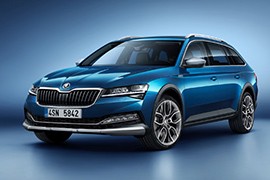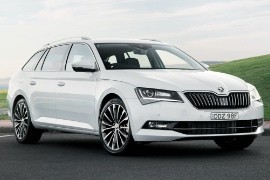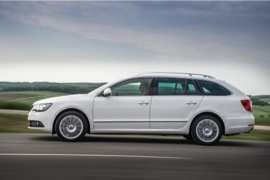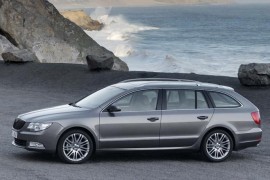SKODA Superb Combi / Scout Models/Series Timeline, Specifications & Photos
First production year: 2009
Engines: Hybrid, Diesel, Gasoline
Body style: Wagon (station wagon, estate, combi, touring)
The fourth generation of the Superb came in two shapes: sedan and station wagon, the latter being traditionally named Combi by the Czech car manufacturer.
Škoda introduced the Superb nameplate in 1934, and it produced that vehicle until 1949, when the automaker had to adapt to its new, after-war status. As a result, it dropped the elegant, V8-powered luxury car and started to build affordable vehicles for the masses. But the Czech brand kept the nameplate in its inventory, and after Volkswagen bought the company in the ‘90s, it started to pursue its new owner to re-create the former flagship model. That eventually happened, and in 2001, a new Superb appeared in Škoda’s lineup.
Starting with the model’s second generation, the automaker produced the car in two shapes: hatchback-sedan and station wagon. The latter was traditionally named Combi by the Czech automaker. Fast-forward to 2023, and Škoda introduced the fourth generation of the Superb and the third generation of the station wagon version.
While the Superb was mostly considered a mid-size vehicle, somehow, it breached into the large-family vehicle segment. Škoda looked like it didn’t really care about traditional standards. It did the vehicles in its own way and won. The station wagon of the 2024 model year Superb shared its front fascia with its sedan sibling, sporting angular-shaped headlights swept-back on the sides and two LED blocks for the high and low beams. These were underlined by bi-color LED stripes that served as daytime running lights and blinkers.
An octagonal grille dominated the car’s front with its chromed vertical slats and featured a pinch on its upper side in the middle. From its profile, the Superb Combi unveiled its massive side panels that continued after the rear doors. Its long roofline ended with a tilted-forward tailgate adorned at its upper side by a roof spoiler.
Like its predecessor, the 2024 Superb Combi featured a vast interior space. At the front of the cabin, customers were greeted by a minimalist-looking dashboard with an instrument cluster filled with a ten-inch display that showed the much-needed data for the driver. In addition, Škoda installed a 13” touchscreen placed atop the center stack in a free-floating position for the infotainment system. Underneath it, the automaker installed three digital dials that included small displays with a haptic feedback feature. As a result, all of them could control various functions depending on how they were rotated, swiped, or touched.
On the center console, the automaker placed the gear selector and a few storage spaces. But the main reason why customers bought the station wagon version of the Superb was its cavernous trunk, which, with the rear seats folded down, provided up to 1,920 liters (67.8 cu-ft) of space.
Under the hood of the third generation of the Škoda Superb Combi, the automaker installed a wide choice of engines that included a mild-hybrid, a plug-in hybrid, three gasoline powerplants, and two turbo-diesel units. All versions were paired with DSG automatic (dual-clutch) transmissions, and the most potent versions were fitted with traction on all corners.
Along with the facelifted version of the Superb’s second generation, Skoda introduced the 2019 Scout version for those looking for a family hauler and a crossover vehicle under the same roof.
The Czech automaker noticed the increased appetite for crossovers and SUVs and tried to please its customers with the compact-sized station wagon Octavia Scout. But still, the market asked for more. As a result, Skoda put some boots on the Superb Combi (the station wagon version of the Superb), increased the car’s ground clearance, added a few version-specific trims on the exterior, and launched it in 2019 for the 2020 model year. The Superb Scout was also the first Skoda in history to feature a hybrid drivetrain carried over from its parent company, Volkswagen.
After four years on the market, the Superb went through a facelift. As a result, the Superb Scout sported the same updates as the rest of its stablemates. At the front, the automaker installed redesigned LED headlights with a sharper look and new DRLs. As an option, customers could opt for Matrix-LED headlamps. Another significant update for the car was the thick chromed trim that surrounded the redesigned front grille. On the lower side of the bumper, the automaker added a light-gray trim that mimicked a skid plate, which made the car look ready for some off-road sessions.
Skoda made the Superb Scout based on the Superb Combi (station wagon). After it lifted the car from the ground by 15 mm (0.6 inch), it added plastic molding around the wheel arches and the side sills. Additionally, the large-sized station wagon sported silver door mirror caps and, around the windows, a chromed trim. On top, the automaker added standard roof rails. The raked-forward tailgate sported a roof spoiler at the back while a chromed stripe crossed it, connecting the redesigned LED taillights.
Finally, under the bumper, another skid plate-looking plastic trim housed the exhausts.
Inside, there were subtle changes that made a difference in terms of perceived quality. The dashboard, the center console, and the door cards were covered with soft-touch materials. In front of the driver, Skoda installed a 10-inch display for the instrument panel that, besides the regular speedometer and tachometer, could also be configured to show the map for the navigation system or other information gathered from the car’s onboard computer. The Superb Scout provided comfortable seats up front and a split-folding bench in the rear where three passengers could sit comfortably despite the transmission tunnel that crossed the car from front to back. Since the Scout was based on the Superb Combi, it featured a large trunk that could reach 1,950 liters (68.8 cu-ft) by completely folding down the rear seats.
Under the hood, at the launch, Skoda offered the Superb Scout with a choice of two engines: a turbo diesel and a turbocharged gasoline unit. Later, a 1.4-TSI hybrid system joined the lineup. All versions were fitted as standard with automatic transmissions and an all-wheel drive system.
Skoda was supposed to be the most affordable brand from the Volkswagen group but ended up offering some of the most impressive station wagons on the market.
The Czech carmaker built the Superb as its flagship model, and then it added a station wagon version. It relied on the same MQB platform as the Golf and the Passat, but it was longer than both of them and provided a massive trunk size. It was so big that it made a minivan feel useless.
With a cubist design language, the Czech mid-size station wagon showed a distinct personality on the European market. It showed a front fascia with angular headlights and a broad grille with vertical slats that hid the radar for the adaptive cruise control in the middle. An additional cooling area brought fresh air for the air-conditioning system on the lower side of the apron, while a pair of fog lights found their place on the outer side. The long roofline started a descending slope at the back, above the rear wheels, at a raked-forward angle. The carmaker traded some storage space for the exterior look.
Inside, the dashboard featured a minimalist design language. Skoda added a 6.5” touch-screen infotainment system as standard for the entire range on the center stack. The carmaker designed the front seats for long-distance trips, while at the back, it installed a split-folding bench that increased the trunk size from 660 liters (23.3 cu-ft) up to 1,950 liters (68.9 cu-ft). A power-operated tailgate was on the options list.
Under the hood, Skoda installed only four-cylinder engines, either turbocharged gasoline or diesel. They were paired with a six-speed manual. For the automatic versions, the carmaker offered either a six-speed or a seven-speed (dual-clutch), depending on the engine and traction.
SKODA Superb Combi / Scout 1.4L TSI 6MT (125 HP)
SKODA Superb Combi / Scout 1.4L TSI 6MT (150 HP)
SKODA Superb Combi / Scout 1.4L TSI 6MT 4x4 (150 HP)
SKODA Superb Combi / Scout 1.4L TSI 7AT (150 HP)
SKODA Superb Combi / Scout 1.8L TSI 6MT (180 HP)
SKODA Superb Combi / Scout 1.8L TSI 7AT (180 HP)
SKODA Superb Combi / Scout 1.6L TDI 6MT (120 HP)
SKODA Superb Combi / Scout 1.6L TDI 7AT (120 HP)
SKODA Superb Combi / Scout 2.0L TDI 6MT (150 HP)
SKODA Superb Combi / Scout 2.0L TDI 6MT (190 HP)
SKODA Superb Combi / Scout 2.0L TDI 6MT 4x4 (150 HP)
SKODA Superb Combi / Scout 2.0L TDI 6MT 4x4 (190 HP)
When it comes to station-wagon vehicles, the Czech company Skoda had an important vehicle on the market: the Superb Combi. In 2013, the model received an important update for both its look and its technical features.
At the time of its launch in 2013, the facelifted version of the Skoda Superb Combi was the class-leader for its trunk space. Along with the Superb Limousine (sedan) version, it was the best selling range for the Czech brand.
When the second generation was launched in 2008, it was criticized for the headlights and taillights look. It kept the idea of the same shape for both front and rear lamps, but in a better way. For the first time, its DRL was used as a turn-signal. It was offered with a choice of 16", 17", and 18".
Inside, there was more room than in most of the cars. Its trunk space was of 633 liters with the rear seats up and up to 1875 liters with the rear seats folded. Due to its station-wagon shape, there was no reason for anyone to complain about the headroom. Three passengers could fit easily on the back seat. As for the driver, the seating position and the features available were unique on the market. The car had an umbrella inside the front or rear door, for instance. For the infotainment system, it featured a standard 5" touch-screen display, and an option for 6.5" was available, with a 30 Gb hard-disk.
For the technical department, the 2013 Superb Combi was available with an automatic parking system for the first time. And the DSG transmission was fitted for the vehicles with all-wheel-drive.
SKODA Superb Combi 1.6L TDI 6MT (105 HP)
SKODA Superb Combi 1.6L TDI 6MT DPF (105 HP)
SKODA Superb Combi 2.0L TDI 6AT (140 HP)
SKODA Superb Combi 2.0L TDI 6AT (170 HP)
SKODA Superb Combi 2.0L TDI 6AT 4x4 (170 HP)
SKODA Superb Combi 2.0L TDI 6MT (140 HP)
Skoda built the Combi version as the biggest model in the Superb.
While some voices said that the Czech brand Skoda shouldn't offer a mid-size premium vehicle, others considered the Superb an excellent addition. The first generation of the Superb, under Volkswagen management, was based on the same platform as the Chinese version of the Passat B5, which was longer than the regular version. Starting with the second generation, the carmaker produced the Superb also as a station-wagon. In 2009, it unveiled the car at the Frankfurt Motor Show, during the world financial crisis, and it was a hit.
The front of the car raised the biggest controversy from the design point of view. While the headlights resembled a reversed shape as the sedan's taillights, they didn't have a usual form. For the station-wagon, they looked even more out of place since the taillights were utterly different. But all the Skoda design elements were there, starting with the grille crossed by vertical slats and followed by the V-shapes on the hood. In the rear, the car featured a sloped tailgate with a roof-spoiler at the top.
Inside, Skoda offered a roomy interior for up to five adults. Its minimalist design trend didn't mean it was cheap-looking. The designers used a clean theme and grouped the controls and features, so they will take minimum space. In the back, the split-folding bench could extend the trunk from an impressive 633 liters (22.3 cu-ft) up to a vast 1.865 (65.86 cu-ft) liters.
Skoda offered the Superb Combi with a wide engine choice, from a small 1.4-liter turbocharged engine to a big, 3.6-liter V6. Some versions were available with an all-wheel-drive system and with an automatic transmission.
SKODA Superb Combi 1.6L TDI 6MT FWD (105 HP)
SKODA Superb Combi 2.0L TDI 6AT AWD (140 HP)
SKODA Superb Combi 2.0L TDI 6AT FWD (140 HP)
SKODA Superb Combi 2.0L TDI 6AT FWD (170 HP)
SKODA Superb Combi 2.0L TDI 6MT AWD (170 HP)
SKODA Superb Combi 2.0L TDI 6MT FWD (140 HP)




